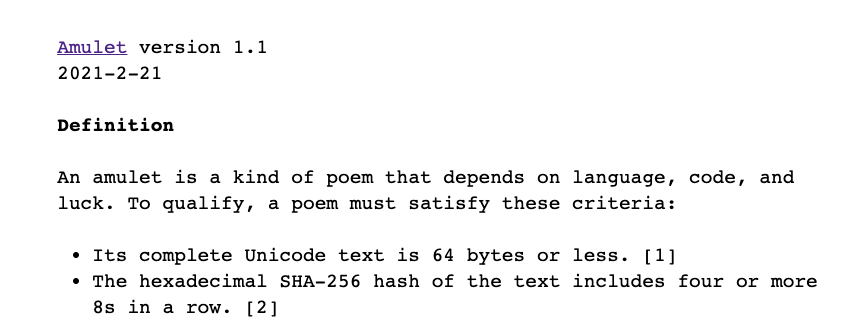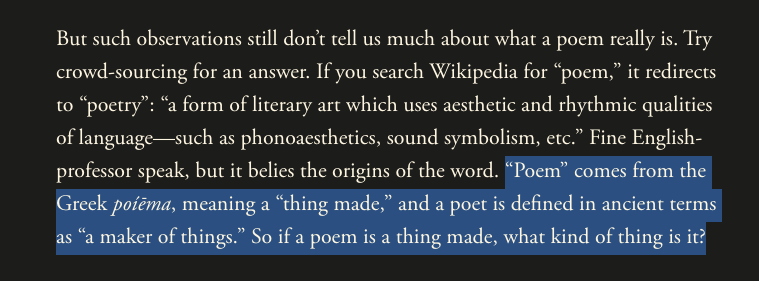I’ve been experimenting with Amulets, Robin Sloan’s1 NFT project, recently. The basic idea of the project is that anyone can find “amulets” and then optionally choose to mint them (with an additional operation required to make it “public” and a unenforceable requirement that a link to a carbon offset is also provided). These amulets are “poems” that satisfy a specific constraint, that they are under 64 bytes and the SHA-256 hex hash of the poem has four or more 8s in a row.

I’ve played with a few simple generative methods to try to find these mythical artifacts, including matching antonyms, pairing emojis, and searching for amulets in the very code I used to generate potential amulets (code here). A couple called out to me that I’ve minted here and here (still need to reveal them but one was dystopia x utopia and other was whole milk ⚖️ skim milk).
This is one of the few “thoughtful” NFT projects that I’ve explored recently. Thoughtful in the sense that it doesn’t feel primarily focused on building lots of clout or making lots of money on artificial scarcity. There’s something strangely compelling about this project—a quiet haven in a space of so much loud chest puffing, furious speculation, and endless scam bots. Part of it is that it encourages play and rewards experimentation. Another piece that makes it compelling to me is the fact that it leverages the web3 medium as a core piece of the underlying art. The whole philosophy behind this project is making meaning out of a seemingly meaningless hash when a lot of NFTs were being boiled down to these illegible, cryptographic alphanumeric strings. It’s a parody on generating the perception of value for something seemingly valueless.
I love that Sloan calls these “poems,” regardless of the form they might take. For example, Andy Matuschak created an image amulet with “legendary” rarity (although it seems like the underlying protocol doesn’t support images). You see people making all sorts of amulets, from traditional poems, to web3 slang, to a toilet emoji.

from what is a poem?
The constraint of the definition of an amulet provides a structure around which to filter for meaning. We do this already with our personal tastes and opinions when creating media, but Amulets specifies formal rules around this implicit filtering. In this way, it removes the initial choice for what makes an artifact valuable (in this case >4 8s in a row in the SHA-256 hash), which gives the creator the freedom to judge value from a smaller set. I wonder how many people who created Amulets have never written a poem for fun and how they think about poetry after interacting with this project. If poems are just “things made” that exist for their own sake and meaning, then these amulets are meaning lighthouses in a space of so much context collapse and narrative war.
Currently, I’m excessively curious about these sorts of text-based, value-provoking projects. I like when we leverage the combination of software and language to challenge people to think about themselves or the world in new ways, and I’m looking forward to diving into this space more.
One related piece I want to try personally is to explore how to create amulets that are personally meaningful, i.e. generated from data and artifacts taken directly from my life (my fits, words, and photos of the day). We generate so much data every day, but most of is lost to the ether or immediately captured by the hungry servers of large corporations. What would it look like to truly own that data and leverage it for our own experiments and fun?
This is the 91st installment in my experiment of publishing raw, lightly edited mini-essays every day towards achieving 100 public pieces. Check out the rationale and the full list here.
-
Robin Sloan is a writer and technologist who is well known for his fictional works and has written about his notes about web3, including skepticisms ↩︎